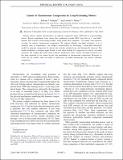Limits of Chromosome Compaction by Loop-Extruding Motors
Author(s)
Banigan, Edward J; Mirny, Leonid A
DownloadPublished version (590.4Kb)
Terms of use
Metadata
Show full item recordAbstract
During mitosis, human chromosomes are linearly compacted about 1000-fold by loop-extruding motors. Recent experiments have shown that condensins extrude DNA loops but in a “one-sided” manner. This contrasts with existing models, which predict that symmetric, “two-sided” loop extrusion accounts for mitotic chromosome compaction. We explore whether one-sided extrusion, as it is currently seen in experiments, can compact chromosomes by developing a mean-field theoretical model for polymer compaction by motors that actively extrude loops and dynamically turnover. The model establishes a stringent upper bound of only about tenfold for compaction by strictly one-sided extrusion. We confirm this result with stochastic simulations. Thus, strictly one-sided extrusion as it has been observed so far cannot be the sole mechanism of chromosome compaction. However, as shown by the model, other two-sided or effectively two-sided mechanisms can achieve sufficient compaction.
Date issued
2019-07Department
Massachusetts Institute of Technology. Institute for Medical Engineering & Science; Massachusetts Institute of Technology. Department of PhysicsJournal
Physical Review X
Publisher
American Physical Society (APS)
Citation
Banigan, Edward J. and Leonid A. Mirny. "Limits of Chromosome Compaction by Loop-Extruding Motors." Physical Review X 9, 3 (July 2019): 031007
Version: Final published version
ISSN
2160-3308